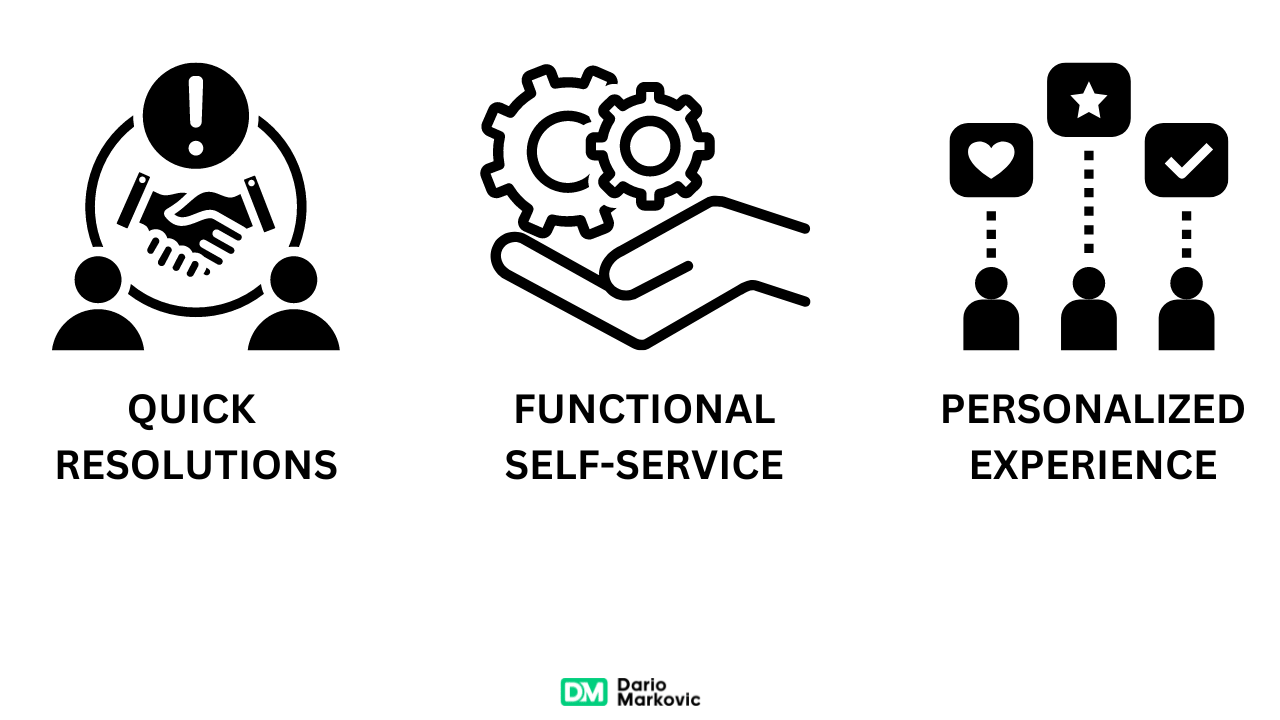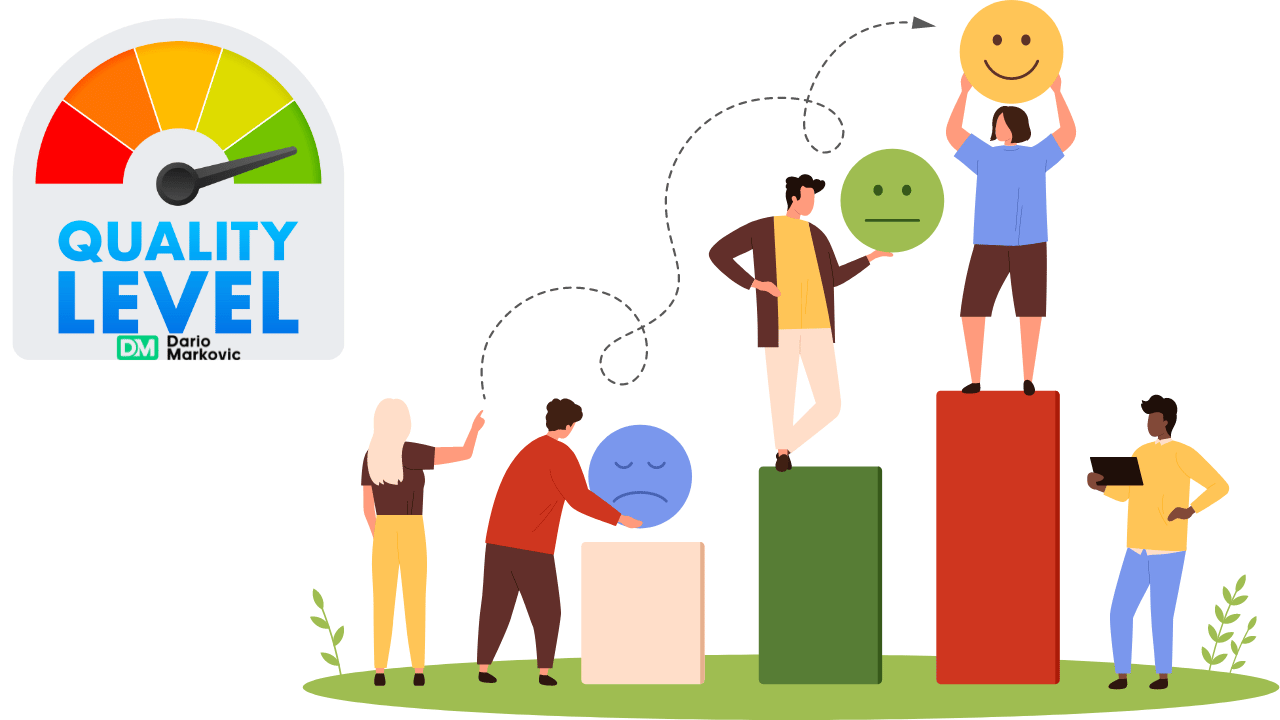What is good customer service? It provides timely, empathetic, and practical support that exceeds customer expectations, building loyalty and boosting profitability. This article outlines how to achieve this, discussing the essential skills and strategies needed for service excellence in the modern marketplace and why good customer service is a critical business driver.

Key Takeaways
- What is good customer service goes beyond courtesy and requires strategies that align with modern customer expectations for immediacy, personalization, and proactive problem-solving, which can significantly increase a company’s profitability.
- Exceptional customer experiences are crafted through personalization, quick and convenient services, and proactive engagement that exceeds customer expectations. This can potentially increase customers’ willingness to pay more for services.
- Continuous improvement in customer service is essential. We rely on KPIs and feedback for performance evaluation and emerging technologies like AI, VR, and AR, alongside CSR considerations, for future enhancement.
Defining What is Good Customer Service: More Than Just a Smile

Providing good customer service extends beyond a warm smile or polite conversation. It entails comprehending the unique identities of your customers and tailoring your service approaches to meet their varied needs and expectations. Embracing contemporary customer demands for outstanding customer service—which includes immediate, personal responses, round-the-clock availability, customized experiences, and proactive problem-solving—is crucial in the modern era that places high value on customer focus.
Firms committed to exceptional customer service are reported to be 60 percent more profitable than those that overlook this aspect. This statistic highlights the importance of meeting and exceeding consumer expectations through great customer service and its substantial influence on an enterprise’s financial success.
The Ingredients of Good Customer Service
The fundamental elements of good customer service include empathy, efficiency, key skills, and consistency. Demonstrating empathy in customer interactions fosters trust, mitigates potential disputes, and cultivates a devoted customer base by acknowledging customers’ viewpoints and validating their emotions.
Equally critical are efficiency and consistency. Customers appreciate when their time is valued through dependable and stable service encounters. This exhibits respect for the customer’s schedule. Ensuring that each engagement with your company leaves satisfied customers reinforces their confidence in your brand.
What is a Good Customer Service Skills That Make a Difference
Customer service skills can make or break a customer’s experience. A great customer service experience involves key qualities that a customer service representative should possess, such as:
- Technical knowledge
- Clear communication
- Patience
- Tenacity
- A positive attitude
They are crucial for effective customer service. For instance, active listening can turn customer interactions into positive experiences by demonstrating that customers are understood and valued.
Moreover, skillful problem-solving can turn challenges into opportunities for customer satisfaction. A consistently positive attitude helps maintain a pleasant service environment, even during stressful customer interactions. In essence, the right set of skills can enhance the quality of customer service and significantly improve customer satisfaction.
The Impact of Technology on Customer Service
Technology is significantly transforming customer service practices and expectations. With advancements like AI, omnichannel platforms, and self-service options, traditional customer service is evolving. Artificial intelligence, for example, is growing in customer service, improving efficiency and personalization.
Self-service options, such as FAQs and user portals, allow customers to quickly find solutions to common issues, saving time for customers and customer service representatives. In essence, technology is changing how customer service is delivered and what customers expect from it, and customer service systems play a crucial role in this transformation.
Crafting Exceptional Customer Experiences

Providing experiences beyond the ordinary and delighting customers is at the heart of exceptional customer service. The objective isn’t merely to satisfy customer expectations but to surpass them in ways that leave a lasting impression. This approach holds significant value, as evidenced by 67% of consumers willing to spend more for an excellent experience.
To achieve this level of service, businesses must address fundamental customer demands, which include promptness, ease of access, and interactions marked by cordiality during service encounters. Companies can meet these requirements by tailoring their services to individual needs, ensuring quick and effortless responses for the customer while proactively engaging with them—this way, predicting their needs before they manifest creates a seamless experience.
Personalization: Tailoring Service to Individual Needs
Catering to each customer’s needs and desires is essential for personalizing their experience. Utilizing data unique to every customer, companies can tailor experiences that resonate with individual preferences and requirements, potentially boosting revenue by 10-15%.
Implementing strategies like addressing customers by name, familiarizing them with their history of support interactions, and segmenting them according to demographic and behavioral information are fundamental components in delivering personalized service. Since 69% of consumers prefer personalized experiences, offering such customization has become indispensable in the current market landscape.
Speed and Convenience: Meeting Customers’ Expectations

Efficiency and ease are vital when it comes to satisfying customer expectations. When engaging with customers over the phone, more than half — 51 percent — expect a reply within five minutes or less. Similarly, 28 percent of customers look forward to the same rapid response time for live chat conversations. These statistics underline the significance of quick reaction times in delivering quality customer service.
Yet, it’s about more than just quickness. Simplicity and clarity in accessing support play a key role, too. Customer confidence and contentment grow when contact details are visible and readily available. Fundamentally, customers value their time greatly—providing prompt and uncomplicated service shows respect for this priority.
Proactive Engagement: Anticipating Customer Needs
Anticipating customer needs involves engaging with them proactively in service interactions and addressing potential concerns before they become evident to the customers. This approach aims to preempt dissatisfaction by resolving issues that could arise early.
Businesses can enhance their customer support by employing technologies such as proactive chat to anticipate and attend to customer needs, providing help precisely when it’s most needed. Proactive engagement essentially means being ahead of the curve regarding customer care by converting possible problems into chances to create favorable impressions.
Strategies for Delivering Great Customer Service
To deliver great customer service is an ongoing endeavor that demands meticulous planning and execution. It encompasses essential strategies such as enabling your team, utilizing customer feedback, and fostering a culture centered on the customer’s needs.
Each strategy contributes significantly to the goal of not just meeting but exceeding customers’ expectations. Equipping your team with the necessary resources and information makes them more adept at serving customers. Similarly, harnessing insights gained from customer feedback highlights opportunities for enhancing service delivery.
Empowering Your Team

Delivering excellent customer service hinges on having a skilled and enabled workforce. Equipping your team with the necessary tools and knowledge ensures customers receive helpful support.
Implementing extensive training initiatives focused on enhancing problem-solving capabilities and offering immediate guidance and assistance can bolster your team’s proficiency in managing customer queries. A thoughtfully structured customer service program can encourage them to strive for superior service excellence by acknowledging their hard work and providing incentives.
Leveraging Customer Feedback
Gathering customer feedback serves as a treasure trove of data, enabling enhancements in the quality of your customer service. It offers critical perspectives on successful elements and identifies areas that require refinement for better performance.
Establishing loops to capture and disseminate this feedback among various teams and incorporating customers’ recommendations is critical to elevating your service level. By effectively gathering input from multiple sources, you can gain a well-rounded understanding of how effective your services genuinely are.
Building a Customer-Centric Culture
Establishing a culture centered on the customer involves:
- Placing the client at the heart of all business tactics and decision-making processes
- Methodically gathering input from customers via multiple platforms
- Utilizing advanced systems to share this feedback across your organization
- Steering company-wide choices to meet and exceed customer expectations
Leading firms such as Walmart, Zappos, Tesla, and Coca-Cola demonstrate commitment to their consumers by offering:
- Tailored interactions with customers
- Initiatives that provide remarkable service experiences
- Participation in local communities
- Timely responses to communications from customers
You’re poised to offer what is good customer service and achieve consistent excellence by embracing these practices within your enterprise. This way, you ensure that great customer service standard outcome for every interaction with a client.
Overcoming Common Customer Service Challenges
While delivering great customer service is essential, it’s not without its challenges. Customer service agents often face various hurdles, from a surge in tickets during crises to managing high requests during peak times.
However, these challenges can be overcome with strategic planning and effective communication. Some strategies to consider include:
- Managing night shifts to ensure consistent customer service round-the-clock
- Developing effective processes for handling increased ticket volumes
- Training customer service representatives to handle customer complaints with grace and professionalism
- Implementing a system for tracking and resolving customer complaints promptly
By implementing these strategies, you can maintain customer satisfaction and protect your brand reputation.
Handling Customer Complaints with Grace
Addressing customer complaints skillfully involves understanding, endurance, and problem-solving capabilities. Employing methodologies such as the HEARD approach—which encompasses Hearing, Empathizing, Apologizing, Resolving, and Diagnosing—can soothe irate customers while showing that their concerns are taken seriously.
It is critical to check back with customers between one to three days after their issues have been addressed. This ensures they are pleased with the resolution and allows them to gather significant feedback. By managing customer grievances adeptly, you can transform potential setbacks into chances to fortify your customer relationships.
Avoiding Service Pitfalls
Despite striving for excellence, there can be lapses in service. Recognizing these mistakes and genuinely interacting with customers when they happen is crucial to maintaining good relations.
Keeping in touch with customers is critical so they don’t feel overlooked. This enhances their overall contentment. Avoiding poor customer service and similar missteps helps guarantee a favorable customer experience, solidify robust relationships with clients, and promote customer loyalty, culminating in their satisfaction.
Measuring and Enhancing Customer Service Performance
Evaluating customer service efficiency and elevating its performance is an ongoing cycle that includes using advanced metrics for assessment and fine-tuning methods based on data analysis and customer feedback.
Companies should consider various elements to maintain a perpetual loop of assessing and improving customer service. These include:
- Metrics related to performance
- Service Policies
- Data gleaned from customer feedback
- Analytics, both in real-time and across historical data
Key Performance Indicators (KPIs) for Customer Service
Monitoring Key Performance Indicators (KPIs) is essential for enhancing customer service performance. Metrics like average resolution time, first response time, and occupancy rate indicate areas that require improvement and enable you to implement appropriate corrective measures.
Evaluating KPIs across communication platforms, such as call centers and online interactions, can provide a holistic view of service efficacy. Concentrating on pertinent KPIs facilitates a systematic methodology based on data to boost the quality of service provided to customers and the productivity levels of service personnel.
Continuous Improvement in Customer Service

Enhancing customer service consistently involves regularly assessing service quality and making appropriate changes, informed by performance data and customer feedback.
For example, integrating cutting-edge technologies like virtual reality (VR) and augmented reality (AR) into customer service training can create lifelike situations that enhance the learning experience. Automating customer feedback collection enables real-time analysis and response to client comments, which promotes ongoing service refinement.
Staying Ahead: Future Trends in Good Customer Service
Maintaining a leading position in customer service necessitates monitoring upcoming trends with vigilance. The landscape is set to be reshaped by advancements such as augmented artificial intelligence, heightened video support capabilities, proactive support initiatives, and an emphasis on ultra-customized experiences.
Customers are developing an acute awareness regarding their data privacy and demand that enterprises protect their sensitive information diligently.
Sustainable practices and ethical considerations within corporate social responsibility (CSR) frameworks are increasingly integral to robust customer service strategies. Keeping abreast of these developments allows companies to remain at the forefront and consistently provide exceptional customer service.
Real-World Examples of Good Customer Service
Practical instances reveal the essence of what is a good customer service. Brands like Zappos and Chewy.com have established high standards for exceptional customer service delivery.
For instance, Zappos interacts with its customers on Twitter, swiftly addressing their problems and generously providing help. In a noteworthy display of compassionate service, Chewy.com sends flowers to express sympathy to customers grieving the loss of a pet. These actions underline how extraordinary customer service can fortify customer bonds and improve a brand’s image.
Dario's Summary
In conclusion, “What is good customer service?” is more than just a smile or a polite conversation. It’s about understanding customers, meeting and exceeding their expectations, and continuously improving your service. Businesses can deliver exceptional customer service by focusing on key components like empathy, efficiency, and consistency and by leveraging technology. Moreover, by empowering teams, leveraging feedback, and building a customer-centric culture, companies can overcome challenges and ensure a positive customer experience. As we move forward, staying abreast of future trends and learning from real-world examples will be crucial in maintaining and enhancing the quality of customer service.
Frequently Asked Questions
Good customer service entails reliably fulfilling customers’ expectations while delivering great customer service that encompasses prompt, tailored, and empathetic assistance that surpasses what customers anticipate, fostering favorable connections with them.
Ensuring the client or customer receives an optimal experience involves attentively heeding their needs, worries, and viewpoints to identify superior solutions. Customer service is fundamentally about ensuring the customer’s satisfaction.
Providing personalized, efficient, easily accessible, and proactive service are the key elements that significantly affect a good customer experience. When aiming for excellent customer service, it is essential to begin with a personal touch.
Technology such as AI, omnichannel platforms, and self-service options can elevate customer service by boosting personalization and efficiency.
To ensure that your team can deliver good customer service, it’s crucial to grant them the authority they need, effectively utilize insights from customer feedback, and foster an environment focused on prioritizing the customer’s needs.
Implementing these tactics can significantly enhance your customers’ overall experience.



